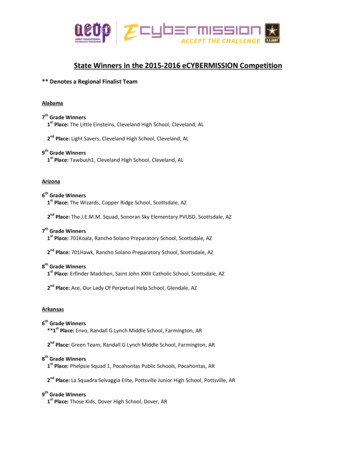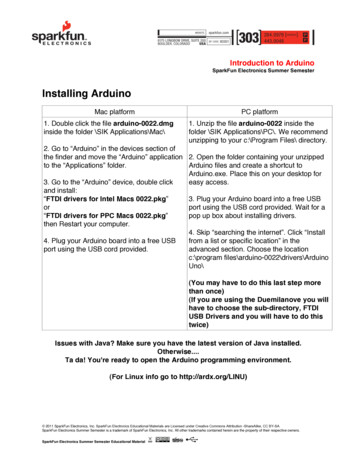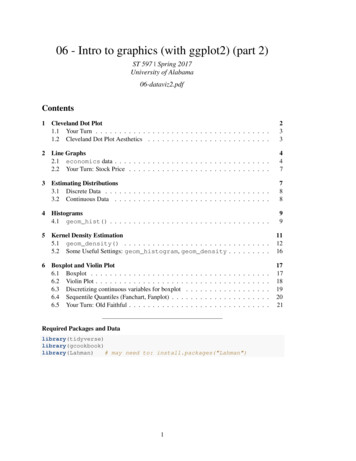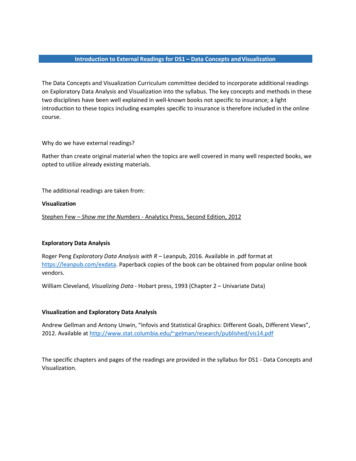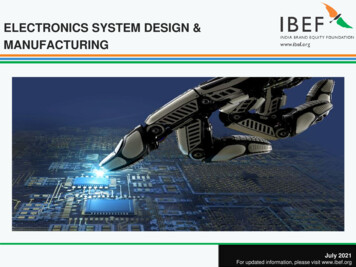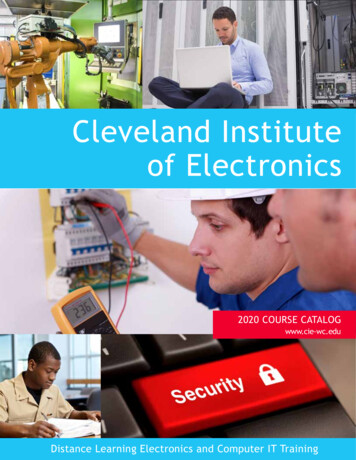
Transcription
Cleveland Instituteof Electronics2020 COURSE CATALOGwww.cie-wc.eduDistance Learning Electronics and Computer IT Training
and fc.ovelCle itute ics, Intn-9400Ins ctro6) 7811e(2l E114hio 44nd, Olevelaeet CtrSth7East 11776tenstituland I ngevelrieCefurthet in thA Lettnteres tep towardiruosryigyou fodent:ng a bthank ou on takive Stuitodtceytprosing antuniate ychangoppor congratulDear Ptssiahfttothkeitalr.y is boe to taE) andns, dig titutenologI’d lik tronics (CI your careeohicteatcircdInsunuteof Ele ucation ancompcomm , Clevelandsdsnedaleesresewinicnicsyourlogy,lectrod in thlectrog.ld of e challengintechno ming or e t you ahearroetwuumpThe dinarilym to pprograin comrested , computer reer prograrextraoetgeableniaowledou’re rtification learning cnykrdenhegaWhet nics, A c a distance, carinogistsicateddelectr tronics hasehnolo uterdctestogcmeneerimpof El ch fields.ong ths in coengineing,eare ams and whether it’ catioskilledg, comy’s indOur fa uals in eduas the ties of toda anufacturinEItier.dCiiveiindplex gh-tech mleaval froncsmieotgcaolueidtechnockle thring, hur graAnd o uipped to ta ast enginee hnology.ng newidraccqwerebest e logy, broad rocessor tg andplenginlatechno s, or microhcthis the way.crobotiu intofme yo very step ooclewesuuh yoLetbe witWe’llther fromentPresidrely,SincerinkoDandallJohn R ntePresidCIE Headquarters, Cleveland, Ohio.A History of Our Growth1934Carl Smith establishesCIE as the SmithPractical RadioInstitute.21956CIE patents theAuto-Programmed method of learning.Enroll on-line at www.cie-wc.edu or call 800-243-64461969CIE develops the firstcustomized laboratorytraining equipment forhome use.
Table of ContentsApprovalsLetter From The President.IFCTable of Contents/Approvals. 3Learning At Home Through Distance Education. 4Employee Education Programs. 5Electronics Technology with Laboratory - Course 1B. 6-7Broadcast Engineering - Course 2. 8Wireless & Electronic Communications - Course 4. 9Industrial Electronics with PLC Technology - Course 5. 10-11Automation and Robotics with Lab - Course 5B . 12-131. Approved by the Ohio State Board ofCareer Colleges and Schools to offerpostsecondary programs of electronics,computer technology and electronicsengineering technology. RegistrationCertificate 70-11-0002H.Contact InformationCleveland Institute of Electronics1776 E. 17th StreetCleveland, OH 44114Call us toll-free (800) 243-6446 or emailus at instruct@cie-wc.edu.Electronics Engineering - Course 6. 14-15Electronics Technology with Digital &Microprocessor Laboratories - Course 14B. 16-17A Certification & Computer Technology - Course 2C. 18-19IT Security - Course 7C. 20-21Every effort was made to assure theaccuracy of this catalog. The ClevelandInstitute of Electronics reserves the rightto make changes in curriculum, facultyand policies. Please consult the appropriatedepartment for current information.Enrollment Information. 22-23Instructional Staff/Authors. 24-25Professional Organizations. 26CIE’s Mission and Goals. 27Grading. 27Code of Conduct. 28Questions and Answers. 291981The Institute of Electricaland Electronics Engineers votes to allow CIEstudents to join IEEE asstudent members.2011Live Video Lectures2014Automation andRobotics Course2018New Egrade LearningCenterComputer SecuritySpecialist Course33
StudyDistance EducationOur graduates agree: distance education offers tremendous advantagesover traditional on-campus training.As a CIE student, you can study on your own time, so you can keep yourpresent job and “earn while you learn”. CIE lets you tailor your educationto your career goals, so you can focus on just the training you need.Have questions, or need assistance?Call CIE Toll-FREE 1-800-243-6446 (CIE-OHIO)www.cie-wc.edu4Enroll on-line at www.cie-wc.edu or call 800-243-6446
Basic Core LessonsYou will find that most of CIE’s courses aredesigned around a core of lessons that coverbasic theories applicable to many areas ofelectronics and computer technology.Course 14B contains the same initial 93lessons that together comprise Course1B. This is the course that teaches basicelectronics, and goes on to increasingly moreadvanced lessons.Intermediate & AdvancedLevel CoursesFor those individuals who already possesssome electronics knowledge, CIE hasdesigned several specific courses.Our intermediate level courses includecourses 2, 4, & 5.You can pick up where your previouselectronics training left off, or update yourpresent skills. These non-laboratory coursescan be the answer to upgrading your skills tothe desired level.A Programmed Approachto LearningCIE has a study method that’s so good, soinnovative, it’s patented.It’s called the AUTO-PROGRAMMED teaching method, and it did nothing short ofsetting a new standard for education throughdistance learning.Personalized Training FromA Dedicated FacultyCIE’s dedicated staff of instructors do morethan just grade your exams; they help guideyou, step-by-step, through your studies andhands-on training. They personally revieweach written report. They’ll encourageyou when you’re doing well, and give yousupport when you need it. Most importantlythey’ll see that every question you havereceives careful consideration by one or moremembers of the staff. You can be sure theresponse, whether it’s a simple explanationor an in-depth theoretical discussion, will beprompt, courteous, and thorough.Optional LaboratoryEquipmentAs a student in a CIE lab course, yourequipment is already included in yourtuition; however, many students preferto purchase professional-quality testequipment to use in commercial or industrialapplications after graduation. To meetthis need, CIE offers optional upgradedtest equipment such as soldering irons,multimeters and oscilloscopes. For thosestudents or re-enrollees who already own labequipment, CIE offers Bookstore credit thatcan be applied toward any product offeredin the Bookstore catalog.Video LibraryAUTO-PROGRAMMED lessons allow you tolearn electronics one step at a time, and youdetermine the size of the step.Watch a CIE instructor discuss a varietyof lessons and hands-on labs in our videolibrary. Log on any time and learn from thecomfort of your own home!Practical, Hands-On TrainingResourcesAs a CIE student, you can train on your ownlaboratory equipment, which assures youthat you can practice whenever you like, andrepeat experiments as often as you need, tomaster them.There is no formal campus or classroomsat CIE, but you will find all the educationalresources of a traditional residentialeducation center here.On-Line ExamsTake your exams online on our e-gradeweb site anytime you want - day or night!Your graded exams will be processed ande-mailed back to you within 24 hours.School CalendarCIE is open every Mon - Fri from 8:30 AM to6:00 PM.CIE is not open the following holidays: NewYear’s Day, Memorial Day, Independence Day,Labor Day, Thanksgiving Day and ChristmasDay. CIE operates a half-day from 8:30 AM to12:00 Noon on Christmas Eve and New Year’sEve. If a holiday falls on a Sunday, CIE will beclosed on the following Monday.We provide the opportunity to purchaseoptional lab equipment and an array ofschool items. we make membershipavailable to an honor society andprofessional associations. and examgrading is available online throughe-grade.CIE BookstoreCD courses covering computers, robotics,satellites, fiber optics, security systemsand other topics related to electronics &computer technology are available to youthrough the CIE Bookstore catalog.The Bookstore catalog also includes studyaids, test equipment, tools, clothing andentertainment items.As a CIE student, you will automaticallyreceive the catalog and may continuereceiving it for as long as you wish after yougraduate.EmployeeEducationProgramsGroup training is available through theCIE Employee Education Program. Thisprogram exists to serve employers whohave the need to train three or moreemployees at the same time.A company can receive substantial tuitiondiscounts for participating in this programand using CIE either as an extension of itsown training program or as a substitutefor one.CIE group training is acknowledged andapplauded by many companies. Theyhave found CIE’s training programs to bea cost-effective alternative or supplementto national company training programs.Specialized TrainingIf you need to modify course work insome fashion to accommodate thespecific needs of a company trainingprogram, we can do that. Consultationwith a CIE Admissions Advisor isnecessary to work out the details.Progress ReportsPeriodic progress reports on eachemployee enrolled under the EmployeeEducation Program is provided to theemployer during training.A proctored final examination is given– at the company’s option – to assuresuccessful mastery of the subject material.Getting StartedCompanies interested in getting moreinformation on CIE’s Employee EducationPrograms should contact CIE’s IndustrialSales Manager at1-800-243-6446(CIE-OHIO).5
COURSE 1BElectronics Technology with LaboratoryCourse DescriptionCourse 1B is designed for students with no previous electronics experience andprovides a solid core of instruction in electronics. Students graduate as readilyemployable electronics technicians or may continue their education with fullacademic and tuition credit applied towards the more advanced CIE programCourse 14B. 93 Lessons with Instructor Support Completion Time Allowed: 24 Months 201 Laboratory Experiments using CIE’s Personal TrainingLaboratory with CIE’s Multimeter Preparation for CET Exam Clock Hours: 1,035What will you learn?This program starts with the basics of electronics andthen moves on to more advanced topics that include: AC and DC circuit theory Identifying components Working with printed circuit boards Relays Robots Regulated power suppliesLessons Troubleshooting digital systems and more Current and Voltage Controlling Current andVoltage Power Distribution Portable Extension Cords Static Electricity Electric Currents andSemiconductor Devices Fractions and DecimalNumbers Reciprocals, Percentages,and Powers of Numbers The Three Basics of ElectricCircuits: Voltage, Current,and Resistance Ohm’s Law, Conductors, andInsulators Connecting and TracingBattery Circuits Identifying Components Tracing Wiring on PrintedCircuit Boards Roots of Numbers, Ratio,and Proportion Inverse Proportion andNegative Numbers Parallel Circuits Equivalent Circuits Applications of Kirchhoff’sLaws Series-Parallel Circuits Voltage and Power Vital Statistics of AC Circuits Magnetism and MagneticCircuits Induced Voltage and Current Thinking Circuits andAutomatic Switches Relays and RobotsScientific NotationUnits of MeasureInductanceMutual Inductance andMagnetic CouplingTransformersElectrical Charges andCapacitanceCapacitors in ActionRectifiers and AmplifiersTransistor and FET AmplifiersReading and Using GraphsPhasors and FormulasReliable SolderingTechniquesWorking with Printed CircuitBoards Building a Siren withFlashing Light Using Your Multimeter toMeasure Resistance Your Personal TrainingLaboratory Series and Parallel ResistorCircuits Power and DC Circuits Simplifying Circuit Analysis byUsing Kirchhoff’s Laws Practical Applications ofKirchhoff’s Laws Currents and Voltages in ACCircuits Capacitors and CapacitiveCircuits Resonant Circuits Inductors and InductiveCircuitsNOTE: The first 36 lessons in Course 1B are also in Courses 2, 4 and 5.6Enroll on-line at www.cie-wc.edu or call 800-243-6446
What is a Certified Electronics Technician? Course 1B includes a study guide on how to prepare for the Associate-LevelCertificated Electronics Technician (CET) exam. This test is administered by the International Society of Certified ElectronicsTechnicians and has over 46,000 certified technicians across the globe!Certification enables employers to separate knowledgeable job applicants fromthose with less training and skills. Courses 2, 4, and 5 also include the CET Study Guide. Resonance and Filters Using Semiconductor Diodes Operation of SemiconductorDevices Working with SemiconductorDiodes Unregulated Power Supplies Operation of Tubes andTransistors Amplifier Circuitry Fundamentals of Transformers Unregulated Power SupplyCharacteristics How To Work With Transistors Transistors - Part I Common-Emitter AmplifierCharacteristics Transistors - Part II Audio Amplifiers andEquipment Operational Amplifiers Operational AmplifierCharacteristics Silicon-Controlled Rectifiersand Unijunction Transistors:Theory and Applications Regulated Power Supplies Regulated Power Supply Characteristics Working With FET’s Radio Frequency Amplifiers Oscillators Sinusoidal Oscillators Measuring and MeasuringInstruments Measurement TechniquesLaboratory Circuit Response toNon-Sinusoidal Waveforms Time Constants RC Filter Circuits Understanding and Using theOscilloscope Optoelectronics Digital Switching Units Binary Coding and ComputerArithmetic Logic Circuit Tracing byUsingBoolean Algebra Digital IC Families withPractical OperatingRequirements Clippers, Clampers, andBinaries Pulse Processing Circuits Multivibrators Important Digital IntegratedCircuits 555 Timing Circuits Digital Systems and How ToTroubleshoot Them Electromagnetism andRelays Systematic Troubleshooting Basic Gates Practical Digital Circuits Sequential Logic CircuitsEND OF LESSONS REQUIREDFOR DIPLOMAOptional Lesson atNo Extra Charge: Associate-Level CET StudyGuideThese lessons are not listed again for those courses in this catalog.7
COURSE 2Broadcast EngineeringCourse DescriptionCourse 2 was designed to provide the specializedknowledge required for a career as a broadcastengineering technician at an AM radio station,FM radio station or at a TV station. 95 Lessons with Instructor SupportIt is also v aluable for the cable televisiontechnician who must maintain and repair studioequipment. Graduates may be eligible to earn a CertifiedBroadcast Technologist certification (CBT) from theSociety of Broadcast Engineers (SBE). SBE is theonly organization devoted to the advancement ofall levels and types of broadcast engineering.Now includes new learning modules on AudioBasics, Advanced Audio and Media along with aninteractive Audio/Video Companion CD.Learn about electronics along with emergingmobile media technologies and postproductiontechniques. Completion Time Allowed: 24 Months Clock Hours: 915 Preparation for CET and FCC ExamsThis course explores important theories and principles relatedspecifically to broadcasting, but because it does not contain anylab work, it is best suited to those students who already havesome previous education or practical experience in electronics.Advanced Audio and MediaStudents learn the techniques and principles necessary for audio production includingLessonsmobile media, game sound, smartphone, tablet, apps and digital audio. Postproductiontopics include a discussion in editing and mixing for television, film, music and mobile media. First 36 lessons from Course 1B(see page 6) Simplifying Circuit Analysis by usingKirchoff’s Laws Currents and Voltages in AC Circuits Resonant Circuits Using Semiconductor Diodes Operation of Semiconductor Devices Unregulated Power Supplies Operation of Tubes and Transistors Amplifiers How to Work with Transistors Audio Amplifiers and Equipment Radio Frequency Amplifiers Oscillators Operational Amplifiers Measuring Instruments Understanding and Using the Oscilloscope Regulated Power Supplies Systematic Troubleshooting Circuit Response to Non-Sinusoidal Clippers, Clampers and Binaries Behavior of Sound Hearing and Perception Studio and Control Room Basics Monitoring Sessions Microphones: Basics and Techniques8 Audio Consoles Recording Sessions Audio Synchronization Audio Signal Processors Audio Editing and Mixing Internet Audio Sound and Meaning Production, Sound and Hearing Acoustics Loudspeakers and Monitoring Microphones Mixers and Consoles Recording Synchronization Signal Processors Audio and the Internet Voice-Overs and Narration Dialogue Recording Studio Production Field Production Sound Design Sound Effects Music Underscoring Mobile Media Production Game Sound Music Recording EditingEnroll on-line at www.cie-wc.edu or call 800-243-6446 Overview of Mixing Premixing and Rerecording forTelevision and Film Music Mixdown Mixing for Mobile Media FCC Review Lessons - Part I FCC Review Lessons - Part II Pointers & Practice for Passing FCCGeneral Class Examination, Part 1 Pointers & Practice for Passing FCCGeneral Class Examination, Part 2END OF LESSONS REQUIREDFOR DIPLOMAOptional Lesson at No Extra Charge: Associate-Level CET Study Guide.See Page 7.
COURSE 4Wireless & Electronic CommunicationsCourse DescriptionCIE’s Wireless and Electronic Communications course was designedto provide a thorough understanding of Wireless and PersonalCommunications along with providing a solid core of instruction inelectronics.This program explores important theories and principles related specificallyto communications, but because it does not contain any laboratory work, it isbest suited to those students who already have some previous education orpractical experience in electronics. 84 Lessons with Instructor Support Completion Time Allowed: 24 Months Clock Hours: 930 Preparation for CET and FCC ExamsWhat will you learn? Basic Electronics Fixed Wireless Diagram and SchematicReading Personal AreaNetworks Component Identification Local Area Networks &Wide Area Networks Digital and DataCommunications Wireless Communications Digital Cellular TechnologyLessons First 36 lessons from Course 1B(see page 8) Simplifying Circuit Analysis by UsingKirchhoff’s Laws Currents and Voltages in AC Circuits Resonant Circuits Using Semiconductor Diodes Operation of Semiconductor Devices Unregulated Power Supplies Operation of Tubes and Transistors Amplifiers How to Work With Transistors Audio Amplifiers and Equipment Radio Frequency Amplifiers Oscillators Operational Amplifiers Measuring and Measuring Instruments Understanding and Using the Oscilloscope Regulated Power Supplies Systematic Troubleshooting Modern Modulation Methods Detection and Frequency Conversion Receiving Equipment Radio FrequencyCommunications Batteries, Control Motors, and OtherPower Sources Frequency Modulation Transmission Lines and Wave Guides Antennas and Wave Propagation Transmitters Suppressed-Carrier Modulation andSingle Sideband Transmission RF Amplifier Analysis Microwave CommunicationsSystems Monochrome and Color Television Programmable Controllers FCC Review Lessons Element 1Part 1 FCC Review Lessons Element 1Part 2 Pointers and Practice for PassingFCC GC Exam Part 1 Pointers and Practice for PassingFCC GC Exam Part 2 Digital and Data Communications Lasers in Communications andIndustry Communication by Fiber Optics Lasers inCommunications andIndustry Communications byFiber Optics Introduction to WirelessCommunication How Wireless Works Understanding Wireless RadioFrequency Communication Infrared Bluetooth Low Speed Wireless Local AreaNetwork High Speed WLANs and WLANSecurity Digital Cellular Phones Fixed Wireless Wireless Communication in Business History of Wireless Communicationand Technical SummariesEND OF LESSONS REQUIREDFOR DIPLOMAOptional Lessons at No Extra Charge: Associate-Level CET Study Guide(See page 7)9
COURSE 5Industrial Electronics with PLC TechnologyCourse DescriptionLearn to troubleshoot PLCs!Course 5 will give a person with no prior experience the skillsneeded to program and troubleshoot PLCs. With the Allen-Bradleysimulator lab, you’ll be able to execute real world projects on yourPC.Students get a well rounded program that includes athorough understanding of industrial electronics and essentialtroubleshooting techniques necessary to maintain, repair andprogram a wide array of industrial electronic equipment includingrobotics, servos and programmable logic controllers.In addition, students graduate with the ability to read andunderstand many different types of schematics and operationalmanuals.This course provides a well-rounded e lectronics education, butbecause it does not contain laboratory work, it is best suited forthose students who already have some previous education orpractical experience in electronics. 78 Lessons with Instructor Support Completion Time Allowed: 18 Months Clock Hours: 930 Preparation for CET Exam (See page 7.)Lessons First 36 lessons from Course1B (see page 6) Simplifying Circuit Analysisby Using Kirchhoff’s Laws Currents and Voltages inAC Circuits Resonant Circuits Using Semiconductor Diodes Operation of SemiconductorDiodes Unregulated Power Supplies Operation of Tubes andTransistors Amplifiers How to Work With Transistors10Enroll on-line at www.cie-wc.edu or call 800-243-6446 Audio Amplifiers andEquipment Radio Frequency Amplifiers Oscillators Operational Amplifiers Measuring Instruments Understanding and Using the Oscilloscope Regulated Power Supplies Systematic Troubleshooting Industrial Control Overview Methods and Operation ofthe Controller DC Motors and Drives AC Motors and Drives Servo Motors andServomechanisms Pressure Systems andTemperature Control Flow Control and LevelControl Systems Analytical and IndustrialInstrumentation Detection Sensors Programmable Controllers PLC Programming,Interfacing andTroubleshooting Motion Control
NewAllen-BradleySimulator!What will you learn? Component identification Robotics AC and DC circuit theory Programmable logic controllers Working with printed circuitboards PLC programming PLC troubleshooting Designing & troubleshooting Servomechanismsmotion control circuits Servo motors Pressure systems and flow Systematic troubleshooting andcontrolmore! Functional Systems Latches Logical Gates Part 1:OR & AND Logical Gates Part 2:NOR & NAND Logical Gates Part 3:XOR, XNOR & NOT Timer Circuits Part 1 Timer Circuits Part 2 Sequencers Part 1 Sequencers Part 2 Counters Part 1 Counters Part 2 Control Circuits ADC/DAC ConvertsEND OF LESSONS REQUIREDFOR DIPLOMAOptional Lesson at No ExtraCharge: Associate-Level CET StudyGuide, (See page 7)11
Course DescriptionLearn how to design, build and test a robot while incorporatingautomation concepts.This course blends multiple disciplines including Electronics, RoboticControls, Automated Systems and PLCs to give students a well roundededucation in Robotic Technology and Automation.With its unique collection of hands-on labs, lessons, exercises, simulationsand interactive media this program will prepare students for a wide rangeof careers in the rapidly growing Robotics Automation field.Best of all, students will actually build, troubleshoot and operate a robot!After you complete this course you’ll be able to master automationtechnologies used in today’s industrial environment.Course 5B includes 48 lessons with instructor support that culminates ina Certificate from Cleveland Institute of Electronics. Completion time allowed is 12 months Clock Hours: 480Learn how to: Troubleshoot robotic systems Program microprocessors Align, fit and assemble robot component parts Maintain, calibrate, tune and programindustrial automated systems Test robotic assembles Develop and test robotic path motionsUnderstand why: Programmable controllers control automation Electronics, circuits and sensors effectautomation controls Hydraulics and pneumatics move industrial robots12Enroll on-line at www.cie-wc.edu or call 800-243-6446DC Circuit TheoryLessonsCOURSE 5BAutomation and Robotics with Lab Current and Voltage Controlling Current and Voltage The Three Basics of Electric Circuits:Voltage, Current, and Resistance Ohm’s Law, Conductors, and Insulators Parallel Circuits Equivalent Circuits Applications of Kirchhoff’s Laws Series-Parallel Circuits Voltage and Power Simplifying Circuit Analysis by UsingKirchhoff’s Laws
Robotics LabThis lab includes hands-on exercises that will show you how to design, buildand program an autonomous robot.It’s a great orientation to electrical and computer engineering with lessonson circuits, components, instrumentation and electronic prototyping. Inaddition, students learn how to troubleshoot computer hardware andsoftware.Starting with basic movement andproceeding to sensor-based projects,students quickly learn how interface asmall semi-autonomous wheeled robotto a microprocessor.AC Circuit TheoryAutomation SystemsMicrocontrollers and Robotics Vital Statistics of AC CircuitsMagnetism and Magnetic CircuitsInduced Voltage and CurrentInductanceMutual Inductance and Magnetic CouplingTransformersElectrical Charges and CapacitanceCapacitors in ActionCurrents and Voltages in AC CircuitsUsing Semiconductor DiodesOperation of Semiconductor DevicesUnregulated Power SuppliesRegulated Power SuppliesBinary Coding and Computer ArithmeticImportant Digital Integrated CircuitsIndustrial Control OverviewMethods and Operation of the ControllerDC Motors and DrivesAC Motors and DrivesServo Motors and ServomechanismsPressure Systems & Temperature ControlFlow Control and Level Control SystemsAnalytical and Industrial InstrumentationDetection SensorsProgrammable ControllersPLC Programming, Interfacing andTroubleshooting Motion Control Industrial Networking Hardware, Software and LEDsPushbuttons and Controlling MotionMeasuring Rotation and Digital DisplaysPushbuttons, Piezoelectric Speaker andControlling MotionTesting the ServosAssembling the Boe-BotNavigation – Tactical and WhiskersNavigation with PhototransistorsIR NavigationRobotic Distance Control and DetectionEND OF LESSONS REQUIREDFOR Certificate13
COURSE 6Electronics EngineeringCourse DescriptionCourse 6 is an advanced-level course designed for techniciansand engineers who want a deeper understanding of electroniccircuits and advanced m athematics.Prerequisites are a high school diploma (or equivalent) with atleast one year of algebra or geometry; or the completion of anyCIE course (or equivalent), an in-depth working experience inthe field of e lectronics, or the permission of CIE’s Director ofInstruction. 89 Lessons with Instructor Support Completion Time Allowed: 30 Months Clock Hours: 1,650Lessons Preparation for CET Exam 14Solving Linear EquationsAlgebraic Signs and ExponentsKirchhoff’s LawsAlgebraic FractionsApplied Fractional EquationsBasic Circuit Principles Applied toPractical DesignDigital Switching UnitsBinary Coding andComputer ArithmeticLogic Circuit Tracing Using BooleanAlgebraPulse Processing CircuitsNetwork TheoremsCoordinates and Angle FunctionsApplications of Trigonometric FunctionsExponents, Radicals and ComplexNumbersPhasor Representation ofSteady-State CircuitsAnalytical Geometry - First DegreeEquations Some Basic Concepts of Calculus Signal Waveforms and Their Application An Introduction to SolidState Design: Part I Advanced Network Theorems Diode Networks An Introduction to SolidState Design: Part II An Introduction to SolidState Design: Part III Ohm’s and Kirchhoff’s LawsApplied to AC Circuits Logarithms Decibels AC Circuit Analysis AC Power and Solving StageCoupling Problems Resonant Circuits Systems of Linear Equations Linear Network AnalysisEnroll on-line at www.cie-wc.edu or call 800-243-6446 Simplifying Network Analysis byUsing Determinants Practical Matrix Theory for Engineers Two Port Linear Networks Quadratic Equations and Systems Higher Order Equations Trigonometric Equations and Identities Theory of Logarithms and Series Natural Logarithms Calculus, Part I: Analytical Geometry Second Degree Equations Calculus, Part II: Basic Concepts inDifferential Calculus Calculus, Part III: Further DifferentialTechniques and Applications of theDerivative Calculus, Part IV: Fundamentals ofIntegration Calculus, Part V: Applying IntegralCalculus Calculus, Part VI: Derivatives ofTranscendental Functions
Learn to Master the Following Topics: Solving Linear Equations Natural Logarithms Digital Switching Units Satellite Communications Solid State Design Digital Communications AC Circuit Analysis Antennas Calculus, Part VII: Integrating Transcendental Functions Calculus, Part VIII: Series Representationsand Indeterminate Forms Calculus, Part IX: Fourier Series andDifferential Equations Digital IC Families with PracticalOperating Requirements Important Digital Integrated Circuits Digital Systems and How To Troubleshoot Them Circuit Response to Non-SinusoidalWavefor
The world of electronics and computer technology is both fast-changing and extraordinarily challenging. , wireless communications, digital A certification, computer programming or electronics, Cleveland Institute of Electronics has a distance learning c
